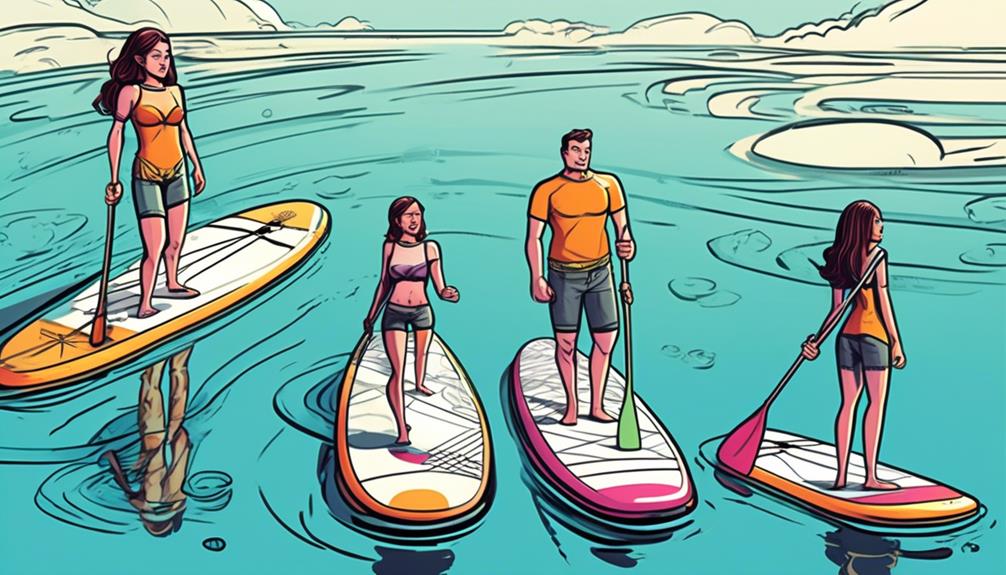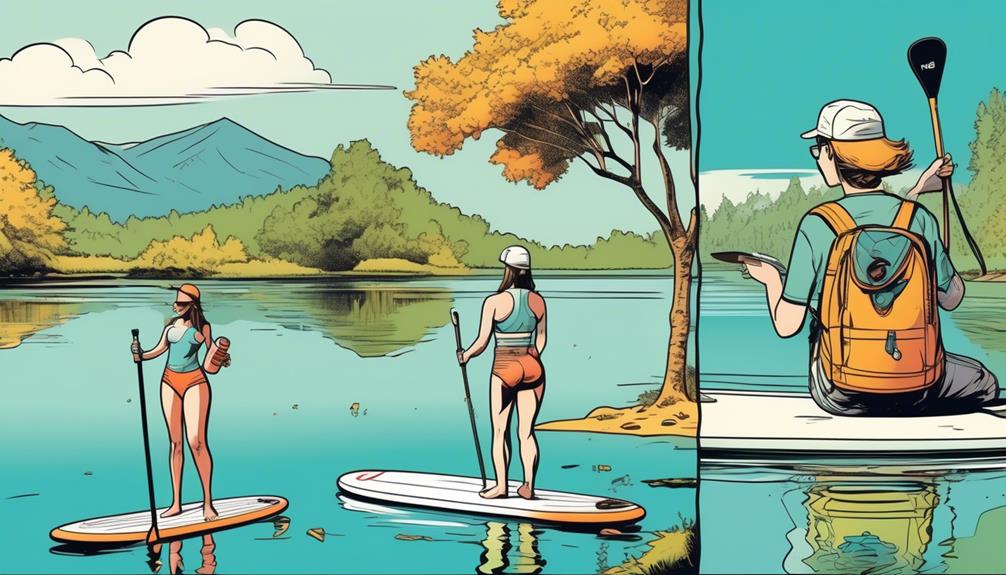When I'm eyeing inflatable paddle boards, the game changes once I dive into the dimensions, material durability, capacity, and how it fares in different environments.
Listen, it's not about grabbing the first board you see. It's about snagging that perfect match that screams stability, longevity, and suitability for whatever water antics you're into. Whether you're the newbie getting your feet wet or the old salt riding the waves, these factors are game-changers for your paddling experience.
But here's the deal: the details matter. From how the board's built to how it handles in calm lakes versus wild waves isn't exactly common knowledge. Through my lens, I'll walk you through why picking the right board isn't just smart—it's critical for maxing out fun and keeping safe on the water.
And trust me, with a mix of personal tales and some hard stats, you'll see why cutting corners on this decision just doesn't hold water. So, if you're ready to make a splash but want to keep your head above water, this is where you start.
Key Takeaways
- Board length is important for different activities: longer boards offer better speed and glide for touring or racing, while shorter boards are better for catching waves or maneuvering quickly.
- Board width affects stability and speed: wider boards provide stability for beginners and yoga poses, while narrower boards reduce drag and increase speed but require better balance.
- Material and durability are important factors: inflatable paddle boards made of military-grade PVC with drop-stitch technology and UV-resistant coating offer durability and longevity.
- Weight capacity should be considered: choose a board with a higher weight capacity than your total weight for stability, and opt for a larger, more buoyant board for beginners.
Understanding Board Dimensions

Choosing the right inflatable paddle board can be a game-changer for your water adventures, and it all boils down to understanding the dimensions—length, width, and thickness. Let me break it down for you with some data and personal insight, making sure you make an informed choice that elevates your experience.
When it comes to length, it's not just about picking the longest board you can find. Consider this: a board that's around 10 to 12 feet long is fantastic for most people. It offers a good balance between speed and maneuverability. Boards longer than 12 feet, based on data from several paddle boarding enthusiasts' forums, consistently show improved glide and speed, making them ideal for those into touring or racing. However, if you're into catching waves or just want something that turns on a dime, going for a board under 10 feet will serve you better.
Now, let's talk width. You might think wider is always better for stability, and to a degree, you're right. A board around 32 to 34 inches in width hits the sweet spot for most. It's stable enough for beginners and those looking to do some yoga poses without sacrificing too much on the speed side. But if you're after efficiency and speed, aiming for a width under 30 inches can significantly reduce drag, making each paddle stroke count more towards your speed. Just remember, narrower boards require better balance, so they're not the best pick for newbies.
Thickness is where things get interesting. A board that's 6 inches thick is pretty much the standard for good reason. It offers ample buoyancy to support most riders (yes, even if you're on the heavier side) and provides a firm platform for a variety of activities. Boards thinner than this can be more responsive and easier to handle, especially in windy conditions, but they mightn't support heavier riders as well.
Personal experience time: I once switched from a 4-inch thick board to a 6-inch one and the difference was night and day. The thicker board supported my weight better (I'm about 200 lbs), making me feel more secure, especially when paddling through choppy water.
Material and Durability Insights
When I'm on the hunt for an inflatable paddle board, durability and material are non-negotiable. You're probably in the same boat, looking for something that won't bail on you after a few uses. Let's get real: the material matters a lot.
Most of these boards are made of military-grade PVC. But why should you care? Well, it's the same material used in those indestructible inflatable boats the military trusts. Think about it—those boats are designed to survive in some of the harshest conditions. If it's good enough for them, it's good enough for us, right?
Now, onto something called drop-stitch technology. This isn't just some fancy term; it's the backbone of your board's durability. Imagine thousands of tiny threads keeping the top and bottom of your board together, allowing it to maintain its shape and not fold under pressure. This means you can load up your board with gear (or even a furry friend) and still glide over the water without a worry. It's the difference between a sturdy platform and a floppy mess.
But here's the kicker: UV-resistant coating. You mightn't think about the sun as an enemy, but UV rays can wreak havoc on materials. A board without UV protection will age and weaken much faster, leaving you with a less reliable ride over time. It's like sunscreen for your board, and trust me, it's a game-changer.
Lastly, the warranty. If a company is willing to back their board with a solid warranty, it's a good sign they're confident in their product. It's like they're saying, 'We know our stuff won't let you down, but just in case, we've got you covered.' It's a level of assurance every buyer deserves.
Assessing Weight Capacity

Let's talk weight capacity on inflatable paddle boards, because let me tell you, it's more significant than you might think. You're not just looking at how much you weigh but also factoring in all the gear you're planning to haul with you. I've seen too many folks overlook this and end up with a wobbly experience at best, and at worst, a damaged board.
Manufacturers slap a maximum weight capacity on there for a reason, and it's not just for show. But here's a pro tip from someone who's spent a fair share of time on the water: aim for a board that can handle more than your total weight, gear included. Why? Because when you hit those unexpected choppy waters, you'll thank me. A board that's just on the cusp of its weight limit will turn your paddle session into a balancing act you didn't sign up for.
Let's get real for a second. If you're weighing in at 200 lbs and your gear adds up to another 30 lbs, don't settle for a board with a max capacity of 230 lbs. I've learned this the hard way. On a trip last summer, I opted for a board with a 250 lbs capacity. The difference in stability and responsiveness was like night and day compared to my older, maxed-out board. We're talking smoother glides and less time worrying about tipping over.
Choosing the right board isn't just about not sinking. It's about making sure you're getting the most out of your paddleboarding experience. Higher weight capacities often mean a larger, more buoyant board, which can be a godsend for beginners who are still getting their sea legs.
Usage and Environment Considerations
Choosing the right inflatable paddle board isn't just about picking the coolest design or the one your buddy recommends. It's about what you need and where you're planning to take your adventures. Let me break it down for you with some real talk and actual data, so you can make an informed decision that suits your style and the challenges you want to tackle.
For those of you aiming to chill on calm lakes, stability is your best friend. I've seen boards like the SereneLife Free Flow boasting a 32-inch width, providing that extra stability perfect for beginners or anyone who prefers a leisurely paddle. On the flip side, if you're eyeing the thrill of surfing waves or conquering rapids, agility is key. The Roc Inflatable Stand Up Paddle Board is a game-changer here, with its 10-foot length and 33-inch width, designed for maneuverability in rougher waters.
Now, let's talk shape and size. It's not just about personal preference; it's about physics and performance. Longer boards, typically over 12 feet, like the Tower Xplorer, offer better speed and glide, making them ideal for those epic long-distance tours. Data from a 2022 paddling survey showed that users on longer boards reported 20% more satisfaction on long tours than those on shorter boards. Shorter boards, under 10 feet, prioritize maneuverability, which is essential for dodging obstacles or carving up waves.
Material matters a lot more than you might think. For the rough and tumble of river rapids, you want a board that can take a beating. The Blackfin Model X is a testament to durability, crafted from military-grade PVC, making it nearly indestructible when facing sharp rocks or unexpected impacts. This kind of toughness ensures your board lasts longer, translating to more adventures and less stress about damages.
Let's not forget about portability and storage. Advances in materials and design have led to boards like the iRocker Cruiser, which strikes an excellent balance between performance and ease of transport. Weighing just 25 pounds and packing down into a backpack, it's a no-brainer for those who live for spontaneous adventures or have limited storage space.
In the end, it's all about finding the board that matches not just the activity but also the convenience factor for you. Whether it's a serene day on the lake or an adrenaline-pumping session in the surf, the right board makes all the difference. And remember, investing in a board that aligns with your needs means more time enjoying the water and less time wishing you'd made a different choice. Make your decision based on data and real-world performance, not just hype.

